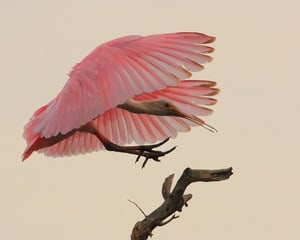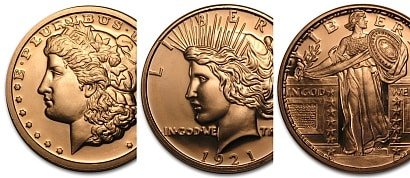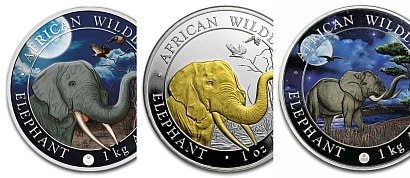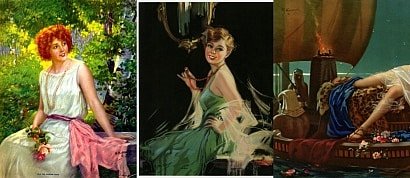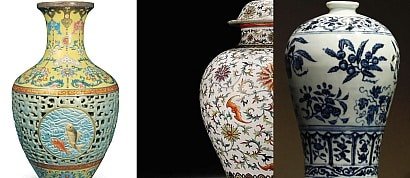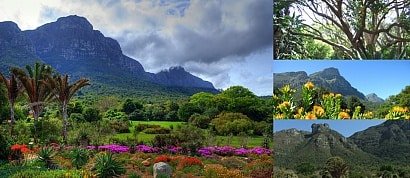Roseate Spoonbills
The roseate spoonbill (Platalea ajaja) (sometimes placed in its own genus Ajaja) is a gregarious wading bird of the ibis and spoonbill family, Threskiornithidae. It is a resident breeder in South America mostly east of the Andes, and in coastal regions of the Caribbean, Central America, Mexico, the Gulf Coast of the United States [ and on central Florida's Atlantic coast Merritt Island National Wildlife Refuge adjoined with NASA Kennedy Space Center.
TAXONOMY
A 2010 study of mitochondrial DNA of the spoonbills by Chesser and colleagues found that the roseate and yellow-billed spoonbills were each other's closest relatives, and the two were descended from an early offshoot from the ancestors of the other four spoonbill species. They felt the genetic evidence meant it was equally valid to consider all six to be classified within the genus Platalea or alternatively the two placed in the monotypic genera Platibis and Ajaja, respectively. However, as the six species were so similar morphologically, keeping them within the one genus made more sense.
DESCRIPTION
The roseate spoonbill is 71–86 cm (28–34 in) long, with a 120–133 cm (47–52 in) wingspan and a body mass of 1.2–1.8 kg (2.6–4.0 lb).[6] The tarsus measures 9.7–12.4 cm (3.8–4.9 in), the culmen measures 14.5–18 cm (5.7–7.1 in) and the wing measures 32.3–37.5 cm (12.7–14.8 in) and thus the legs, bill, neck and spatulate bill all appear elongated. Adults have a bare greenish head ("golden buff" when breeding and a white neck, back and breast (with a tuft of pink feathers in the center when breeding), and are otherwise a deep pink. The bill is grey. There is no significant sexual dimorphism.
Like the American flamingo, their pink color is diet-derived, consisting of the carotenoid pigment canthaxanthin. Another carotenoid, astaxanthin, can also be found deposited in flight and body feathers.[9] The colors can range from pale pink to bright magenta, depending on age and location. Unlike herons, spoonbills fly with their necks outstretched. They alternate groups of stiff, shallow wingbeats with glides.
BEHAVIOUR
This species feeds in shallow fresh or coastal waters by swinging its bill from side to side as it steadily walks through the water, often in groups. The spoon-shaped bill allows it to sift easily through mud. It feeds on crustaceans, aquatic insects, frogs, newts and very small fish ignored by larger waders. In the United States, a popular place to observe roseate spoonbills is "Ding" Darling National Wildlife Refuge in Florida. Roseate spoonbills must compete for food with snowy egrets, great egrets, tricolored herons and American white pelicans.
REPRODUCTION
The roseate spoonbill nests in shrubs or trees, often mangroves, laying two to five eggs, which are whitish with brown markings. Immature birds have white, feathered heads, and the pink of the plumage is paler. The bill is yellowish or pinkish.
THREATS
Information about predation on adults is lacking. Nestlings are sometimes killed by turkey vultures, bald eagles, raccoons and fire ants. In 2006, a 16-year-old banded bird was discovered, making it the oldest wild individual.
(Wikipedia)
TAXONOMY
A 2010 study of mitochondrial DNA of the spoonbills by Chesser and colleagues found that the roseate and yellow-billed spoonbills were each other's closest relatives, and the two were descended from an early offshoot from the ancestors of the other four spoonbill species. They felt the genetic evidence meant it was equally valid to consider all six to be classified within the genus Platalea or alternatively the two placed in the monotypic genera Platibis and Ajaja, respectively. However, as the six species were so similar morphologically, keeping them within the one genus made more sense.
DESCRIPTION
The roseate spoonbill is 71–86 cm (28–34 in) long, with a 120–133 cm (47–52 in) wingspan and a body mass of 1.2–1.8 kg (2.6–4.0 lb).[6] The tarsus measures 9.7–12.4 cm (3.8–4.9 in), the culmen measures 14.5–18 cm (5.7–7.1 in) and the wing measures 32.3–37.5 cm (12.7–14.8 in) and thus the legs, bill, neck and spatulate bill all appear elongated. Adults have a bare greenish head ("golden buff" when breeding and a white neck, back and breast (with a tuft of pink feathers in the center when breeding), and are otherwise a deep pink. The bill is grey. There is no significant sexual dimorphism.
Like the American flamingo, their pink color is diet-derived, consisting of the carotenoid pigment canthaxanthin. Another carotenoid, astaxanthin, can also be found deposited in flight and body feathers.[9] The colors can range from pale pink to bright magenta, depending on age and location. Unlike herons, spoonbills fly with their necks outstretched. They alternate groups of stiff, shallow wingbeats with glides.
BEHAVIOUR
This species feeds in shallow fresh or coastal waters by swinging its bill from side to side as it steadily walks through the water, often in groups. The spoon-shaped bill allows it to sift easily through mud. It feeds on crustaceans, aquatic insects, frogs, newts and very small fish ignored by larger waders. In the United States, a popular place to observe roseate spoonbills is "Ding" Darling National Wildlife Refuge in Florida. Roseate spoonbills must compete for food with snowy egrets, great egrets, tricolored herons and American white pelicans.
REPRODUCTION
The roseate spoonbill nests in shrubs or trees, often mangroves, laying two to five eggs, which are whitish with brown markings. Immature birds have white, feathered heads, and the pink of the plumage is paler. The bill is yellowish or pinkish.
THREATS
Information about predation on adults is lacking. Nestlings are sometimes killed by turkey vultures, bald eagles, raccoons and fire ants. In 2006, a 16-year-old banded bird was discovered, making it the oldest wild individual.
(Wikipedia)
Added to
People who voted for this also voted for
Malaysia
Bullion Rounds: Copper
Mexican Lobby Cards (35)
Maternità della Beata Vergine Maria
Beautiful Korean Faces - Kim Tae-hee
Santa Maria Maddalena
Western Movie Posters: Jack Hoxie
Dream World Love and Romance Magazine
Bullion Coins: Silver Elephant Series (colorized)
My Perfect Lebanese Beauties
Artwork by Hy Hintermeister
Telefoni bianchi
Pasqua di Risurrezione
Sabato Santo - Discesa di Cristo agli inferi
Beautiful Chinese Faces - Fei Fei Sun
More lists from Kenji
Blists Hill Victorian Town
Pakistan
Paintings of Ships and Boats
Valuable Chinese vases & porcelain
My Bird Lists
Great Gardens: Kirstenbosch, Cape Town, S.Africa
Great Gardens: Adachi Museum of Art, Japan
 Login
Login
